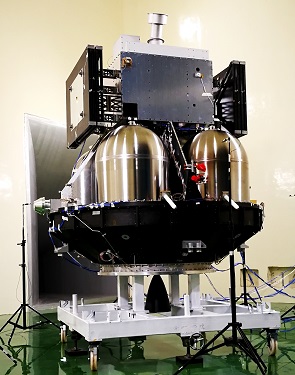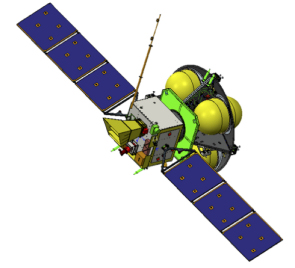Spacecraft
In launch configuration, the SMILE spacecraft consists of a 3.15-m-high stack of a platform plus a payload module whose dimensions are compatible with either an Ariane 6 or Vega-C launcher.
At the top of the stack the payload module carries the four scientific instruments that will be used to study the interaction between the solar wind and the Earth's magnetic field.
 |
| SMILE spacecraft structural model. Credit: IAMC/CAS |
The platform is 3 axis stabilised and provides the spacecraft resources as well as raises the orbit from the insertion orbit (SSO or LEO) to the science orbit. At the base of the stack, the propulsion subsystem of the platform has four 350-litre fuel tanks that feed an engine capable of delivering 490 newton of thrust. The rôle of the propulsion subsystem is to push SMILE into a highly-elliptical, inclined orbit (HEO) after separation from the launcher. This orbit will take SMILE to a maximum height of 121 000 km above the Earth, far enough to allow the boundary of the Earth's magnetic field to be imaged.
When the fuel tanks are full, the total weight of the stack will be around 2200 kg.
The platform structure is made from an aluminium sandwich with carbon-fiber frames. It supports two deployable solar arrays with a combined area of 5.8 m² that supply a set of lithium-iron batteries with a total capacity of 60 Ah. Two star trackers and twelve 10-newton thrusters are used for attitude control and two antennas will transmit telecommands and spacecraft housekeeping data to the ground station. A single 20-mm-thick, 1m-by-1m aluminium honeycomb sandwich plate forms the top cover of the platform and the base plate of the payload module.
 |
| Artist's impression of the SMILE spacecraft. Credit: CAS/ESA |
The payload module carries three instruments — two imagers operating in the ultraviolet (UVI) and X-ray (SXI) wavelengths, and one in situ instrument (MAG) for measuring the solar-wind magnetic field. The UVI and SXI are mounted on the main platform, while the MAG's two sensor heads will be positioned 80 cm apart along a deployable 3-m-long boom to reduce the influence of magnetic fields generated by the spacecraft. The fourth instrument will measure solar wind ions (LIA) and its sensors will be mounted on the platform.
SMILE will be three-axis stabilised, so that the SXI and UVI can continuously point towards their magnetospheric and auroral targets. However, since this requires pointing close to the direction of Earth, a baffle is required to shield the CCDs of the SXI from unwanted light pollution, bringing the total SXI height to 95 cm. The science data collected by the four instruments will be transmitted from the payload module using an X-band antenna.
SMILE is a joint mission between the European Space Agency (ESA), that will provide the payload module and the launcher, and the Chinese Academy of Science (CAS), that will provide the platform.
